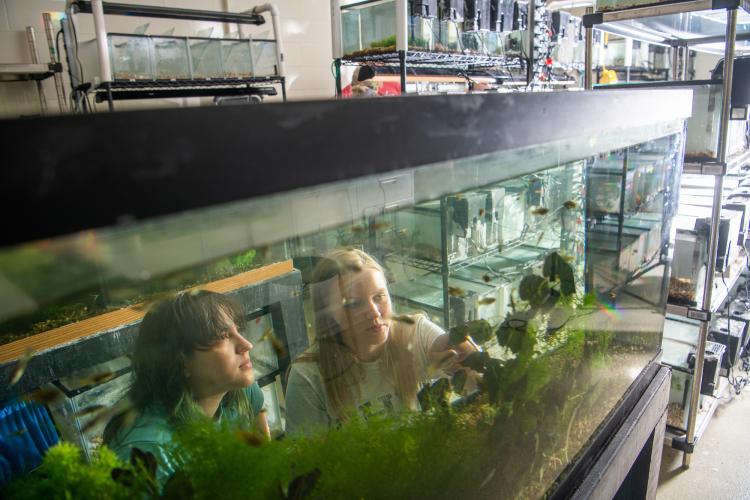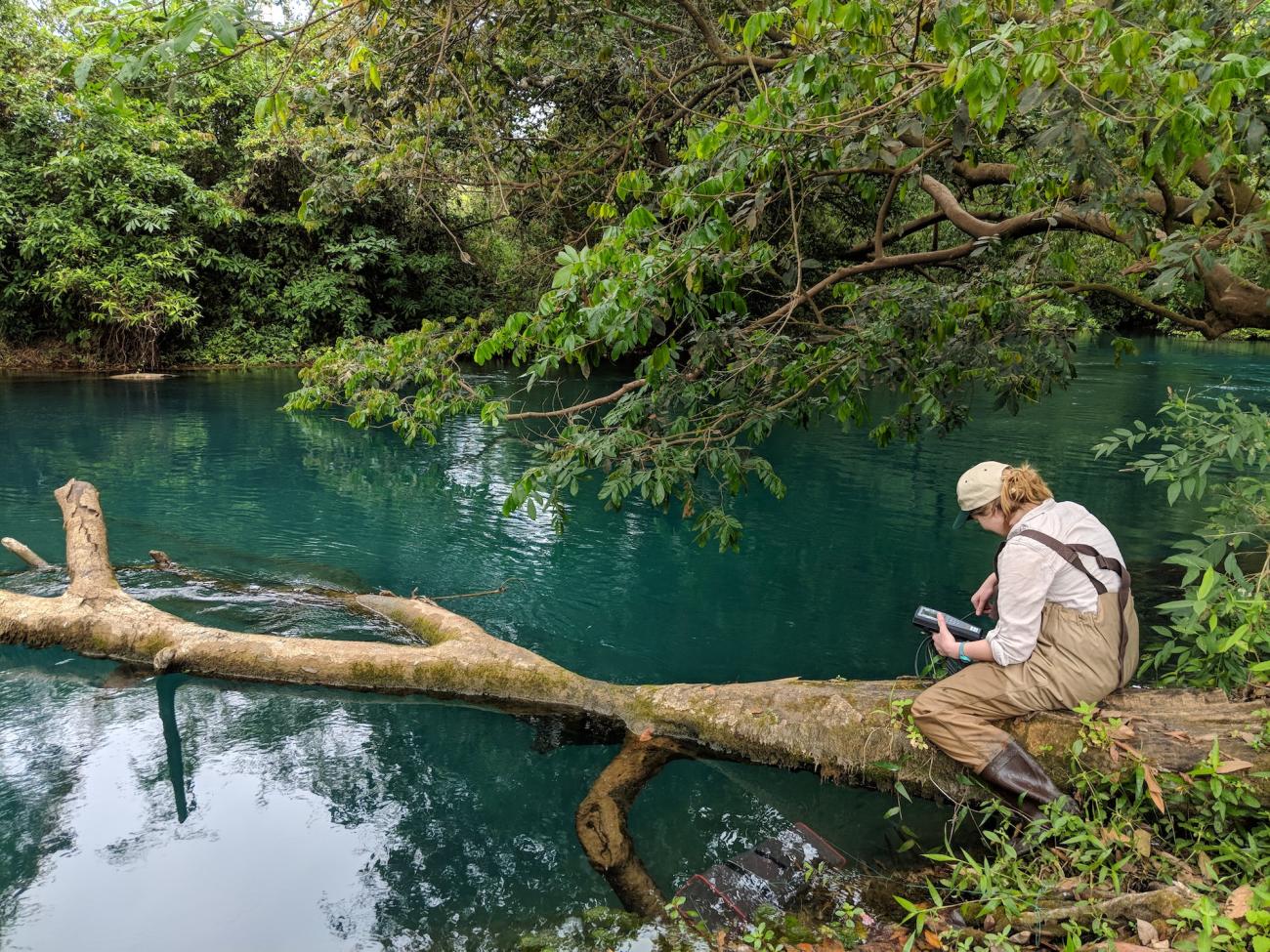

A biology lab filled with thousands of freshwater fish from Mexico provides a hands-on setting for Ohio University students to examine how tiny, colorful swordtail fish are evolving and adapting.
Dr. Molly Morris , professor of Biological Sciences in the College of Arts and Sciences, provides plenty of experiential learning opportunities in her lab, where students report having fun while taking care of the fish, developing their own research projects and acquiring aquatic biology-related jobs when they graduate.
The Morris Laboratory houses several species of swordtail fish that researchers study, looking at how their mating behaviors evolve and how they communicate, reproduce, and adapt to stress.
Currently, the lab houses 2,000 fish, with some in individual tanks and others in large breeding mesocosms.
“I have felt very supported by Ohio University in terms of maintaining this huge colony efficiently,” Morris said.
Students who work in the lab divide their time between maintaining the fish, getting involved in a research project and reporting each week in a group meeting about how their research is going. They also read and discuss current research articles each week, Morris explained.
“I always like to tell them that you can do [research] one of two ways. You can sort of really focus in on one project and contribute enough that even in one semester you may be a coauthor on a publication. You can also look at it from the perspective of, ‘I want to learn as many different skills in the lab as possible during my time here,’” Morris said.
Graduate students and undergraduate students are able to work and learn together in the Morris Lab.
‘A fun lab to work in’
Madison Parker, a senior and marine, freshwater, and environmental biology major from Napoleon, Ohio, is a PACE student worker in the lab this summer. Part of her duties include cleaning, setting up and monitoring fish tanks, and she also has trained fellow students due to her past experience in the lab. Parker has also had some research opportunities in the lab. She has worked on a video simulation for the fish, as well as assisted graduate student Meredith Fitschen-Brown with female mate preference testing for Fitschen-Brown’s research project (see below).
“I’ve learned a lot in the lab, even when an experiment doesn’t work,” Parker said. “Last semester, I was on this pellet study, and it didn’t work at all. But Dr. Morris and I talked about it, and she asked my input on it, which was really cool, just trying to see if we could improve the experiment. [Being in the lab has] just been a great experience.”
Helen Stec, a senior and neuroscience major in the Honors Tutorial College from Chicago, Ill., wrapped up her research project this summer. She focused on counting neuron numbers of male swordtail fish to get more insight into how certain males are more behaviorally plastic, or adaptive, than others.
“Dr. Morris’ lab is a fun lab to work in. There are always projects to help others on and she is always interested in what ideas you bring to the table,” Stec said. “Everyone in the lab is always willing to help both with actual tasks and just bouncing off ideas.”
‘Gave me a lot of transferable skills’
Both Parker and Stec noted that working in the lab has helped them critically think and problem-solve better.
“I’ve learned how to use my thinking skills for example, be able to figure out what’s wrong with the filters that aren’t working,” Parker said. “I think it’s really helped me expand how I think and what’s important and how science experiments work in real life.”
“Working in the lab gave me a lot of transferable skills. It taught me how to do dissections as well as fish care and maintenance,” Stec said. “More importantly, [Dr. Morris’] lab has shown me the back side of research and has taught me how to think critically.”
Fitschen-Brown, a Ph.D. candidate in the biological sciences department from Lansing, Mich., enters her fifth year with the lab this fall. Her research work focuses on how contaminants, such as nitrates, in the water can affect fish mating behaviors and environmental stress impacts in the green swordtail fish.
“Nitrates exist naturally in the environment, but due to nitrogen fertilizers, nitrate concentrations are increasing in streams which causes a multitude of problems for aquatic life,” Fitschen-Brown said. “We are testing the impact of nitrates on mating behaviors of wild fish sampled from both pristine and contaminated waterways.”
In her graduate work, Fitschen-Brown notes that being able to mentor undergraduates and conduct collaborative work is one of her favorite parts of the Morris Lab.
“[As graduate students] we get to learn how to mentor undergraduates, which is really exciting,” she said. “If you want to be in a research leadership role, learning how to talk to people and delegate responsibilities is a great asset this lab has given me.”
Keith Tompkins, a Ph.D. candidate in evolutionary biology from Seymour, Conn., has worked in the lab for two years. Currently, he is working on a project looking at why certain fish grow a nuchal hump on their head from fatty deposits while in the lab but not in the wild. He is examining how both behavior and environmental influences, like temperature, influence the propensity to fat deposition.
“I am gaining research experience, which entails forming working hypotheses, collecting and analyzing data and communicating results to other members of the scientific community,” Tompkins said. “[It is] always interesting with so many different projects being conducted [in the lab].”
“We took on extra students this summer, and I feel really lucky with the students that I landed. They’re all doing a really great job,” Morris said.
‘There’s a lot of flexibility’
For many of Morris’ students, a favorite part of working in the lab is working with and connecting with other students as well as having the flexibility to learn about and research projects that interest them.
“There’s a lot of flexibility … because we have so many fish and we have sufficient space, we have the ability to ask questions and create projects that we are interested in,” Fitschen-Brown said. “It’s a really positive lab to be in. Everybody wants to be here to learn, which creates a pleasant environment.”
“When we get together, everybody is so curious about different things and it always seems like there are more questions to be asked and more experiments to be done,” Parker said.
Graduates of Morris’ lab continue to expand their knowledge or work directly in the aquatic biology field after graduating from OHIO. Shasta Kamara ’21 will start her master’s degree in marine and environmental biology this fall at Nichols State University. Mary Reichle ’20 landed her dream job with Superior Fish, an aquaphonics farm. Kathleen Cook ’20, a former PACE student in the lab, now works as an animal tech to research assistant II at Cincinnati Children’s Hospital.
These professional achievements, and all student endeavors, are cheered on by Morris.
“All three of these past students were PACE students in the lab, and they have taken this experience and used it to land related positions after graduation,” Morris said. “Part of the reason that they can do that is that I don’t just tell them to feed fish or assign them a project, but they have choices, a lot of responsibility in the lab and they are reliable.”
Parker encourages any students interested in research that it is never too late.
“For other students that might want to get involved with research and are thinking about it, it’s a great idea to get experience, and it’s a lot easier than you might think it is to get into a lab, even if you feel like you’re late to the game,” she said.
Keep up to date with the swordtail fish biology lab and the lab students’ accomplishments at www.ohio.edu/cas/labs/morris-lab .






